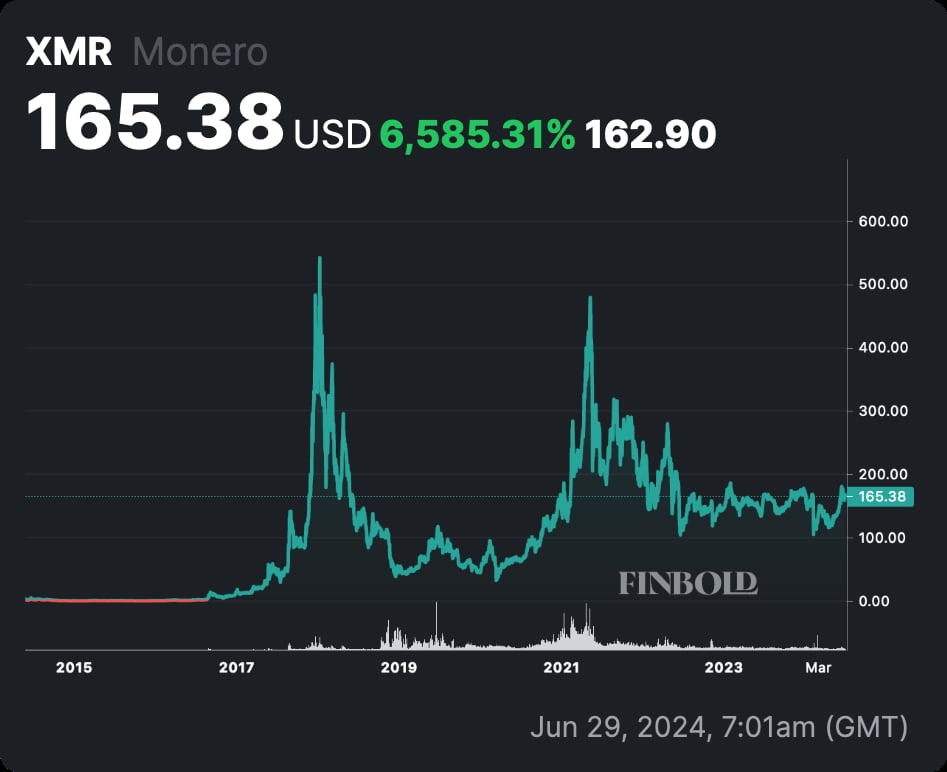The cryptocurrency market is full of opportunities and value asymmetry that sharp observers can benefit from. On that aspect, market capitalization is a powerful benchmark to trace comparisons between competing projects for a fundamental analysis.
In particular, the currently $3 billion Monero (XMR) stands out with strong fundamentals, hinting at an undervalued capitalization. Monero is one of the solid contenders that is gradually capturing part of Bitcoin’s (BTC) market share among cryptocurrencies.
The project has most of Bitcoin’s praised strengths and benefits from more efficient transactions, an improved proof-of-work system resistant to ASIC’s centralization, and a battle-tested privacy-by-default network.
As of this writing, Monero trades at $165.38 with a $3.09 billion market cap, ranked 28th. A ride to $15 billion would effectively increase its price by five times to $826, making new highs. Interestingly, this move would require only exactly 1% of Bitcoin’s $1.20 trillion capitalization.

Leading privacy and adopted cypherpunk cryptocurrency
The cryptocurrency has a battle-tested privacy-by-default solution for peer-to-peer money transfer, often praised by grassroots communities and old-time Bitcoin supporters.
For example, in September 2020, the United States Internal Revenue Service’s criminal investigation division (IRS-CI) posted a $625,000 bounty for contractors who could develop tools to help trace Monero. This bounty was never claimed, suggesting such a tool does not exist.
Recently, Peter Thiel, an old-time Bitcoin supporter, billionaire, and co-founder of PayPal, questioned BTC’s current state based on the foundational vision that got him interested. Thiel mentioned the cypherpunk, crypto-anarchist, libertarian, and “anti-centralized government” ideals as a core for Bitcoin’s value proposition.
“Does it [BTC] really work that way? Or has that thread somehow got lost? So, when people in the FBI tell me that they much rather have criminals using Bitcoin than hundred-dollar bills, it suggests that, maybe, it’s not quite working the way it was supposed to. I have a dual reason. One is this sort of ideological, decentralized future of the computing world that I really do believe in. I really believe it would be better, and it [Bitcoin] seemed like the perfect vehicle for that for such a long time, and I’m just much less convinced that.”
Peter Thiel
Conversely, Monero has been conquering this original vision, as well as markets previously dominated by BTC. The darknet markets are a clear example of adoption and use case, but also th share of mind from cypherpunk influencers and commentators. Additionally, XMR has increased its usage share and dominance in Clearnet marketplaces, such as gift card crypto providers.
War on privacy and Monero’s resilience
Notably, leading governments worldwide have declared war on financial privacy and, more specifically, Monero through arbitrary law enforcement.
In particular, the European Union has prohibited anonymous payments. Meanwhile, the United States and the Netherlands have led enforcement actions against open-source developers, raising concerns even from known cryptocurrency critics.
This scenario has remarkably given more strength to Monero, attracting more supporters to the cause and increasing its awareness. All of a sudden, XMR has become the first and second favorite cryptocurrency of many enthusiasts, increasing its potential.
Despite being delisted from major crypto exchanges like Binance and OKX, XMR trading surged in decentralized exchanges like Haveno. Buyers have been reportedly paying a premium to acquire Monero in these “street” markets, evidencing the demand for the coin.
In conclusion, XMR has a bright future ahead within the cypherpunk and other grassroots cryptocurrency communities that once supported Bitcoin.
In a positive scenario for adoption and surging demand, Monero’s price could increase dramatically as it eyes the $15 billion market cap, potentially ranking among the most valuable cryptocurrencies. Nevertheless, XMR must overcome relevant challenges for this hypothetical rally, including in the liquidity and regulatory spectrums.
Disclaimer: The content on this site should not be considered investment advice. Investing is speculative. When investing, your capital is at risk.









